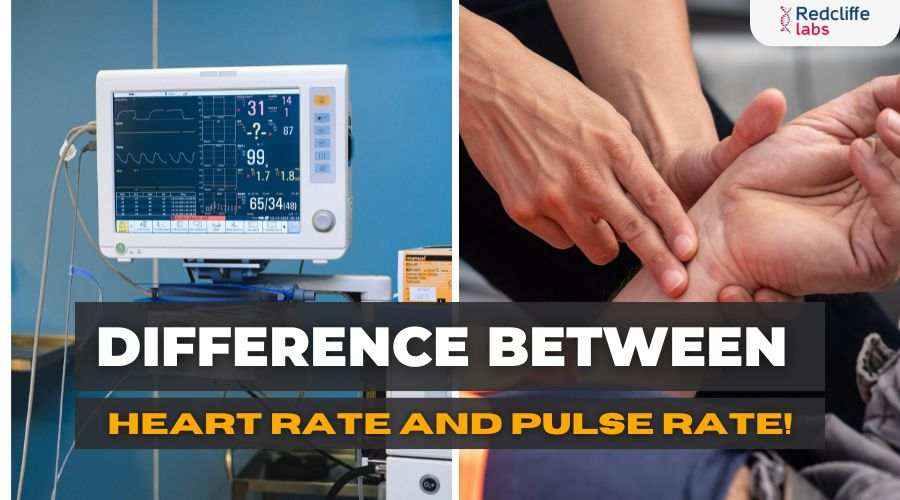Difference Between Heart Rate and Pulse Rate!

Medically Reviewed By
Dr. Geetanjali Gupta
Written By Muskan Taneja
on Aug 22, 2024
Last Edit Made By Muskan Taneja
on Jul 19, 2025

The function of pulse rate and heart rate is similar. Both provide the same information, i.e., heartbeats per minute. The primary difference between heart rate and pulse rate is the measuring purpose. Pulse can be measured from the side of the neck, wrists, inside your elbow, and even the top of the foot. Heart rate and pulse rate are important parameters to monitor an individual's health and well-being.
Pulse rate is another name for heart rate. Adults' heart and pulse rate is 60-100 beats per minute. However, certain factors can affect the functioning of the system. Let’s understand the difference between heart rate and pulse rate.
What is Heart Rate?
A heart rate is the number of heartbeats in a minute. It is the key factor in driving your heart's ability to pump blood throughout your entire body. The normal range of heart rate is 60 to 100 heartbeats per minute. However, age, fitness level, BMI, illness, injury, medication, pain, hormones, and nicotine can affect the range. Any abnormality in the heart rate can lead to cardiovascular diseases.
What is the Normal Range Of Heart Rate?
The normal range of heart rate varies based on age. Here is a breakdown of normal heart rate by age:
Bpm- beats per minute
|
Age |
Range |
|
Newborns (1-30 days) |
100-205 bpm |
|
Infants (1-11 months) |
100-180 bpm |
|
Toddlers (1-2 years) |
98-140 bpm |
|
Preschoolers (3-4 years) |
80-120 bpm |
|
School-age children (5-12 years) |
75-118 bpm |
|
Adolescents (13-18 years) |
60-100 bpm |
|
Adults (above 18) |
60-100 bpm |
How To Measure Heart Rate?
The procedure for measuring heart rate is very simple. You can perform it manually by placing the tip of your index, third, and second finger on the palm side of your wrist. This is the most recommended and performed method. Some measure heart rate by applying their index and second fingers on either side of the windpipe.
Several wearable devices are available in the market to measure heart rate. Simply wear the device on your finger and measure the heart rate. These devices may provide additional information regarding your heart health.
The ultimate method of measurement is the ECG or electrocardiogram. An ECG provides every minute detail related to the heart. You can get the ECG test from Redcliffe Labs. The ECG test helps monitor the heart’s activity and rhythm to diagnose heart disease.
What is Pulse Rate?
Pulse rate is another name for heart rate. There is no major difference. Both methods help determine the number of heartbeats per minute. The number of times a person’s artery expands and contracts is simply a pulse. The parameter indicates overall heart health from strength to efficiency. You can measure pulse rate through the wrist, groin, or neck. Conducted when an artery is near skin.
What is The Normal Range of Pulse Rate?
The normal range of pulse rate also varies based on age. Here is a breakdown of a normal pulse rate by age:
|
Age |
Pulse Rate |
|
18-20 years old |
81 |
|
21-30 years old |
80 |
|
31-40 years old |
78 |
|
41-50 years old |
75 |
|
51-60 years old |
73 |
|
61-70 years old |
73 |
|
71-80 years old |
74 |
|
80 or above |
78 |
How To Measure Pulse Rate?
You can measure the pulse rate using different methods. These are manual palpation, pulse oximeter, wearable devices, and mobile apps. One can measure pulse rate through wrists, side of the neck, inside elbow, and even top of the foot. Manually, you can count the number of pulses within a period. Pulse oximeters are small devices that calculate pulse rates. Meanwhile, mobile apps and wearable devices use sensors to measure and calculate pulse rates.
What’s The Difference Between Heart Rate And Pulse Rate?
The heart rate measures the time a heart beats in a minute, while the pulse rate measures the rate of blood pulses through the arteries. The difference between the heart rate and pulse rate is clear.
|
Category |
Heart Rate |
Pulse Rate |
|
Definition |
Number of times the heart beats in a minute. |
Number of times the blood vessels pulse through the arteries in a minute. |
|
Measuring device |
ECG |
Wearable devices and pulse oximeters |
|
Detects |
Heart health |
Health of the cardiovascular system |
|
When |
When at rest, during exercise, or a medical procedure. |
Anything, while during physical activity or stress. |
|
Normal range |
60 to 100 beats per minute. |
60 to 100 beats per minute. |
|
Abnormal rate |
Underlying heart conditions such as tachycardia or arrhythmia. |
Underlying conditions such as dehydration or shock. |
|
Factors affecting |
Age, sex, fitness level, and medications. |
Stress, age, fitness level, BMI, and medications. |
|
Uses |
To check changes in heart health over time. |
To check changes in cardiovascular health. |
8 Factors That May Affect Heart Rate And Pulse Rate
Age is a common factor that affects heart rate and pulse rate. Other factors may affect heart rate and pulse rate, too. These factors include:
- Emotions such as stress
- Body Mass Index (BMI)
- Body position, such as sitting or standing
- Medications, especially thyroid medications
- Sex and gender
- Fitness level
- Body weight
- Temperature
10 Tips for Maintaining Normal Heart Rate and Pulse Rate
Now, you must understand the basic difference between heart and pulse rates. Several factors affect the functioning of heart rate and pulse rate. We have listed above these factors. However, there are certain tips through which you can maintain a normal heart rate and pulse rate.
- Add whole grains to your diet.
- Reduce stress and keep your mind calm.
- Consume omega-3 fatty acids foods.
- Maintain salt level.
- If you are a non-vegetarian, add fish to your diet.
- Limit caffeine and alcohol intake.
- Avoid smoking.
- Include green-leafy vegetables in your diet.
- Practice deep-breathing practices, such as yoga and meditation.
- Maintain a healthy weight or BMI.
Key Takeaways
Heart rate and pulse rate are similar yet different. Pulse rate is also known as heart rate. The measuring process is unique, yet both measure heartbeats. A heart rate can detect the overall functioning of heart health. Meanwhile, a pulse rate can detect the overall functioning of cardiovascular health. It is very common to believe heart and pulse rates are the same. However, the information they provide and the process they use to measure are different; otherwise, everything is the same.
Want to know your heartbeat functioning and overall heart health? Redcliffe Labs offers a cardiac profile-essential test package, where you can check your cardiac health and know your heart and pulse rates. So, why wait? Book the test today!
Leave a comment
2 Comments
Vijitha Weerasekara
Dec 26, 2024 at 12:17 PM.
Good.better explanation
Myhealth Team
Dec 30, 2024 at 11:55 AM.
Thankyou! We are glad you have liked the information.
Mohini
Oct 25, 2024 at 2:26 AM.
Very good
Myhealth Team
Oct 30, 2024 at 8:41 AM.
We are glad you have liked the information.





